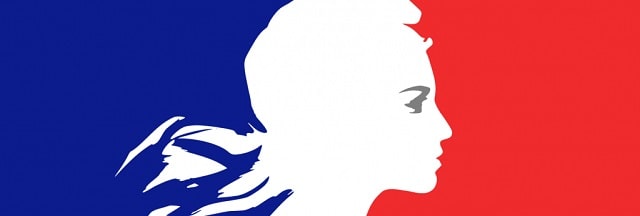La France : un état laïque


France : a secular state
“Laïcité” is a word for which no exact equivalent exists in English. This explains the difficulties we have when trying to explain to people from other European countries, and particularly from Britain, what lies behind this idea, but it is important to know the meaning of “laïcité” if we want to understand how it affects life in France from many points of view. This article proposes to give a very simple and rapid description of an ideal consecrated by the law voted just one hundred years ago, in 1905: the separation of the church and the state. This year, on December 9th, we celebrate the centenary, and several events have already taken place in Limousin.
History
Under the “Ancien Régime”, before the French Revolution of 1789, the Divine Right of the Monarchy, where the king derived his sovereignty and authority from God, required that all his subjects have the same religion as he, in France the Roman Catholic religion, confirmed by the coronation and anointment. This principle was respected more or less rigorously by all the European states. For different reasons at certain periods, other religions were tolerated as long as they remained discreet – for example, the Jews, the Roman Catholics in England under the reign of Charles 1, the Protestants of the Reformed Church of France. However, this often led to cruel repression and even to veritable civil war, as in France with the persecution of the Protestants.
To begin with, the French Revolution officially recognized the Catholic Church on one condition: that the priests pledge allegiance to the delegates of the people (“prêtres jureurs”). This system was rejected by the Catholic hierarchy, the Vatican and the Royalists, and their opposition resulted in a real civil war in certain very Catholic regions such as Brittany and Vendée, with terrible repression. Later, during the reign of Napoleon 1 in particular (the Empire), a Concordat between the Vatican and the state of France was signed: Catholicism became the official religion, the priests were paid by the State, and the latter nominated the bishops in agreement with the Pope. Napoleon saw in the Concordat mainly a means of maintaining civil peace.(For historical reasons: the annexation by Prussia from 1870 to 1918 of certain departments of Alsace and Lorraine – the system is unfortunately still in application in some parts of France.)
During the whole of the 19th century this state of things saw many upheavals, the “parti clerical” and the Pope still hoping to restore Catholicism to its former privileged situation, abolishing the freedom of choosing another religion or of refusing all faiths – and even the liberty of the press. It was not until the beginning of the 20th century that total secularization of the state was established.
The Separation of Church and State (1905 Law)
After much discord and opposition, the law was voted in December 1905. The first two articles stipulated the following:
-The Republic ensures freedom of thought. Any religion may freely be practised, with only certain restrictions in order to preserve public order.
-The Republic recognizes (in the sense of acknowledge), employs or subsidizes no religious cult whatsoever.
That meant that all expenses linked to the previously acknowledged churches were no longer paid by the state, the departments and the communes. However, the cost of maintaining the services provided by the different religions in hospitals, boarding schools and prisons, for example, where the ‘inmates’ could not freely practise their chosen religion outside, continued to be paid. (This is still the case, and leads to problems occasionally in the case of Islam, which had no clergy in France in 1905.)
The application of the law, in spite of its many advantages, was not easy to enforce, but was really only a continuation of what had been changing in the mentalities of the French people since the Revolution.
According to the established principal specifying that the Republic does not recognize or subsidize any religion, all the churches that existed at the time belong to the nation, which has the duty of their upkeep, as historical monuments. The clergy retain the right to use the buildings to celebrate their services. (This has led to a remarkable state of conservation of all these edifices built before 1905, which were considered a national heritage.)
The law also implies that no new place of worship can be subsidized, such as mosques for the Muslims, because the practise of one’s faith is considered a purely private affair. On the other hand, the adepts of any religion whatsoever can build a place of worship with their own funds, as long as they respect the laws of urbanism.
The consequences for those in public employment:No person employed by the state is permitted to show his or her religious or political convictions when on duty, in particular with visible and distinctive signs. Strict neutrality is required of public servants, and disciplinary action in case of non-respect could even go as far as dismissal.
The consequences in state schools:The secularization of French State schools had started long before the 1905 law. Already in 1881, elementary education was free, compulsory from 6 to 13 in 1882 and already “laïque”, with no religious education, Thursday being free for the parents to provide it for their offspring if they wished. In 1886, the clergy were no longer allowed to teach in state schools. Other laws were enforced, notably the secularization of the armed forces, hospitals, hospices, even cemeteries, and public prayers were prohibited. Already during the Revolution, such ideas for schools had been put forward, notably by Condorcet, so the seeds had long been sown.
Still today, any show, by clothing, badges, speech or in writing, of religious beliefs or political opinions is strictly forbidden. (e.g.: swastika, crucifix, turban, Islamic headscarf, kippa). This is stipulated in order to avoid any proselytism, but above all to show young people that they can live together and respect each other, whatever their differences, and without betraying their convictions.
Conclusion
The principle of “laïcite” and of the separation of Church and State is at present well established in France – the fundamental principles at least, in spite of occasional breaches, the presence at religious ceremonies of republican officials representing their function, for instance. The different faiths recognize that in the law they find protection and the guarantee of their freedom to practise, which is considered a strictly private affair. This is true especially of the minority religions: the Reformed church, Judaism, and most of the Muslims.
Centuries and terrible struggles were necessary to arrive at this wise principle. Today, certain Muslims have difficulties accepting the distinction between divine law, the sharia, and civil law, but that was the case of the Christian churches in centuries gone by. One must let time go by and do its job!
Few countries in the world have adopted the principle of a secular state, but there are some examples: for example, Mexico, a country almost exclusively Roman Catholic, and to a certain extent, Turkey, a Muslim country. Yet some Christian groups in the United States and other Muslim fundamentalists have the impudence to accuse France of religious persecution!
Note: British readers interested in the history of “laïcité” and fluent in French may enjoy the excellent work of Jean Cornec, “Laïcité”, published in 1965.
Share to: Facebook Twitter LinkedIn Email
More in alsace, brittany, education, history, legal, schools, work
By FrenchEntrée
Leave a reply
Your email address will not be published. Required fields are marked *



